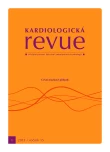Arrhythmias and stroke
Authors:
doc. MUDr. Petr Heinc, Ph.D.; MUDr. František Kováčik; MUDr. Marie Lazárová; MUDr. Jan Přeček; MUDr. Aleš Smékal; Doc. MUDr. Miloš Táborský, CSc.; Fesc; Mba
Authors‘ workplace:
I. interní klinika – kardiologická FN Olomouc
petr. heinc@fnol. cz
Published in:
Kardiol Rev Int Med 2013, 15(1): 33-36
Category:
Overview
Significant arrhythmias occur in approximately 25% of patients hospitalized for acute stroke, their incidence is highest in the first 24 hours and decreases during the first three days. It is assumed that arrhythmias are primary of the neurogenic cause and obviously are independently associated with older age and with greater neurological disability, which leads to a corresponding release of transmitters into the circulation. Atrial fibrillation is the most common arrhythmia associated with stroke and the follow-embolic etiolology is the cause of about 20% of all stroke. A patient with a history of atrial fibrillation who remains in tromboembolic risk despite of any antiarrhythmic intervention must be anticoagulated by Warfarin or novel anticoagulants according to risk stratification (i.e. CHA2DS2Vasc score).
Keywords:
stroke – arrhythmias – atrial fibrillation – CHA2DS2Vasc score
Sources
1. Perk J, De Backer G, Gohlke H et al. European Guidelines on Cardiovascular Disease Prevention in Clinical Practice (version 2012). EHJ 2012; 33 : 1635–1701.
2. Norris JW, Froggatt GM, Hachinski VC. Cardiac arrhythmias in acute stroke. Stroke 1978; 9 : 392–396.
3. Reinstein L, Gracey JG, Kline JA et al. Cardiac monitoring in the acute stroke patient. Arch Phys Med Rehabil 1972; 53 : 311–314.
4. Lavy S, Yaar I, Melamed E et al. Effect of acute stroke on cardiac functions as observed in an intensive stroke care unit. Stroke 1974; 5 : 775–780.
5. Kallmünzer B, Breuer L, Kahl N et al. Serious cardiac arrhythmias after stroke. Incidence, time course, and predictors – a systematic, prospective analysis. Stroke 2012; 43 : 2892–2897.
6. Myers MG, Norris JW, Hachinski VC et al. Cardiac sequelae of acute stroke. Stroke 1982; 13 : 838–842.
7. Hilz MJ, Moeller S, Akhundova A et al. High NIHSS values predict impairment of cardiovascular autonomic control. Stroke 2011; 42 : 1528–1533.
8. Hockman CH, Mauck HP, Hoff EC. ECG changes resulting from cerebral stimulation. II. A spectrum of ventricular arrhythmias of sympathetic origin. Am Heart J 1966; 71 : 695–700.
9. European Stroke Organisation (ESO) Executive Committee; ESO Writing Committee. Guidelines for management of ischaemic stroke and transient ischaemic attack 2008. Cerebrovasc Dis 2008; 25 : 457–507.
10. Adams HP Jr, del Zoppo G, Alberts MJ et al. American Heart Association/American Stroke Association Stroke Council; American Heart Association/AmericanStroke Association Clinical Cardiology Council; American Heart Association/American Stroke Association Cardiovascular Radiology and Intervention Council; Atherosclerotic Peripheral Vascular Disease Working Group; Quality of Care Outcomes in Research Interdisciplinary Working Group. Guidelines for the early management of adults with ischemic stroke: a guideline from the American Heart Association/American Stroke Association Stroke Council, Clinical Cardiology Council, Cardiovascular Radiology and Intervention Council, and the Atherosclerotic Peripheral Vascular Disease and Quality of Care Outcomes in Research Interdisciplinary Working Groups: The American Academy of Neurology affirms the value of thisguideline as an educational tool for neurologists. Circulation 2007; 115: e478–534.
11. Furie KL, Kasner SE, Adams RJ et al. Guidelines for the prevention of stroke in patients with stroke or transient ischemic attack. Stroke 2011; 42 : 227–276.
12. European Heart Rhythm Association; European Association for Cardio-Thoracic Surgery. Camm AJ, Kirchhof P, Lipp GY et al. Guidelines for the management of atrial fibrillation: the Task Force for the management of Atrial Fibrillation of the European Society of Cardiology (ESC). Eur Heart J 2010 : 31 : 2369–2429.
13. Čihák R, Haman L, Heinc P. Souhrn aktualizace doporučených postupů ESC pro léčbu fibrilace síní z roku 2012. Cor Vasa 2012; 54: 532–541.
14. Lip GY, Halperin JL. Improving stroke risk stratification in atrial fibrillation. Am J Med 2010; 124 : 111–114.
15. Pisters R, Lane DA, Nieuwlaat R et al. A novel userfriendly score (HAS-BLED) to assess one-year risk of major bleeding in patients with atrial fibrillation: the Euro Heart Survey. Chest 2010; 138 : 1093–1100.
Labels
Paediatric cardiology Internal medicine Cardiac surgery CardiologyArticle was published in
Cardiology Review

2013 Issue 1
Most read in this issue
- The most important diagnostic procedures in acute stroke
- Therapy of acute ischemic stroke
- Prevention of ischemic stroke
- Arrhythmias and stroke
